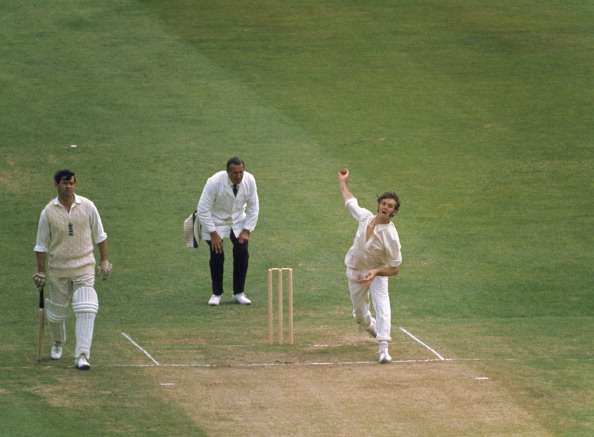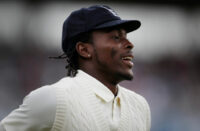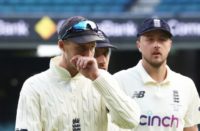Alex Narey on the impact of good and bad debuts, and recalls Bob Massie’s finest hour for Australia in 1972
Chris Morris must have been wondering what he had done to deserve it. It is the morning of Sunday, January 3, and just 24 hours after being handed his South Africa Test cap, the 28-year-old is being thrashed to all corners of Cape Town’s Newlands ground as Ben Stokes sets about rewriting history. It is an entry into the game’s highest echelons that has descended into nothing but a nightmare.
Was it bad luck or just bad bowling? Well, possibly both, although Sky Sports’ Bob Willis was quick to claim the latter as he ran the rule over Morris’ hapless return of 1-150 from 28 overs at a heart-wobbling economy rate of 5.35 runs per over.
Playing a supporting – and unwanted – role to one of cricket’s most destructive Test innings is something Morris is going to have to accept when he is forced to regale with tales of only his second day in Test cricket.
With every delivery during that Stokes onslaught, the ball would have felt less controllable and the batsman (or batsmen if you consider Jonny Bairstow’s sideshow) would have seemed more like 50 yards away rather than 22.
No matter where he bowled, Morris was cow-corner fodder and even though both Morne Morkel and Kagiso Rabada were dismissed with similar impunity, it was the debutant who would have been turning in his sleep the most that night, fretting that his legacy at the game’s top table had been done and dusted with South Africa seemingly unlikely to get another shot at their opponents with the ball after England had racked up that daunting 629-6.
To Morris’ credit, he came good later in the Test. His 69 runs at No.8 were collected with as much ease as any of his fellow countrymen, and then, with South Africa sensing and chasing the most unlikely of final-day victories under cloud cover, he delivered a spell of pace and accuracy that had England’s batsman hopping for cover.
It was a timely nudge to the selectors to leave the door open – which they duly did by selecting him again for the Wanderers Test this week – and proof perhaps that he could survive in the cauldron of Test cricket – although we’re sure that Willis will still take some convincing on that point.
While Morris may have joined the ‘second chance’ brigade – something Graham Gooch, a pair on debut in 1975, wrote the blueprint for doing – there are many others who have not been so fortunate.
Picked for the last Test of the 1995 series against the West Indies after a season of solid form for Sussex, Alan Wells faced just one ball in England’s first innings, looping a catch to short leg off Curtly Ambrose.
He fared better in the second dig, but three runs – naturally – were not enough to convince the England hierarchy that he was up to the job.
Warwickshire’s Andy Lloyd faced the ultimate baptism of fire when he fronted up to the West Indies’ four-pronged attack of Malcolm Marshall, Michael Holding, Joel Garner and Eldine Baptiste at Edgbaston after earning his Test cap in June 1984.
Opening the batting and with ten runs in the bank, he looked reasonably at ease, until the skidding and electric Marshall found some extra lift short of a length and sent Lloyd spiralling to the deck with a nasty blow to the temple.
Lloyd recovered, but only to walk off the field before being hospitalised for a week with blurred vision. He played no more first-class cricket that season, and an England recall was never forthcoming.
The technical aspect aside, debuts are emotional beasts. At the highest level, a player’s inclusion is scrutinised intensely by the media in the modern age. But no matter what standard of the game you are playing, it is a box that has to be ticked at some stage and if things don’t run to plan, the scarring can be permanent – and not just in a physical sense, as in Lloyd’s case.

It is with horror that this contributor can recall every single one of the 12 deliveries I bowled on my university 1st XI debut some 21 years ago. Leeds Metropolitan Uni (now Leeds Beckett Uni and Leeds Polytechnic in old money) was hardly anything to rival Oxford or Cambridge, but there was certainly a feeling that I didn’t belong in the cricketing top set.
There was no shortage of egos in that changing room; with players keen to tell you about looming county contracts, Minor County fixtures or the myriad international stars they had rubbed shoulders with in the hard-nosed Bradford and Lancashire Leagues.
My own reputation was built off the fact that I had come close to rattling a few lids in winter nets. I was probably the last name on the teamsheet, and not just when the skipper came to drawing up the batting order.
Still, our coach, Ralph Middlebrook – a straight-talking Yorkshireman who ran the local Academy at Headingley and whose son, James Middlebrook, has enjoyed a stellar first-class career – seemed to like my huff and puff.
Sadly, huff and puff got me nowhere on a cold and windy May day as I went to pieces.
I didn’t even look in the book to see the figures, but would like to claim that I at least opened an end up for my bowling partner to wreak havoc on the way to his match-winning 8-34.
Considering how tough debuts can be, we should cherish and remember the good ones, or, in the case of Robert Arnold Lockyer Massie, the truly great ones.
After making his first-class debut in 1965, Massie, a tall, right-arm medium pace bowler who swung the ball both ways – late – did not have the game to nail down a place in his state side, Western Australia. There were pockets of brilliance, but, by and large, his performances in Shield cricket did little to justify his long-term selection and he was generally called into action only when Test guns such as Graham McKenzie were away on international duty.
After a series of ins and outs – a period of time that saw him rejected by Northamptonshire and forced to play league cricket for Kilmarnock in the Scottish leagues – Massie eventually did enough to convince Western Australia he was worth sticking with during the 1970/71 season, and national recognition followed with a place on the touring party to England in 1972.
After the tourists had lost the first Test, Massie made his debut at Lord’s, and with a mixture of teasing away swingers and slippery in-duckers, ran through England’s experienced line-up with some ease.
His first wicket in Test cricket was Geoffrey Boycott, castled through the gate. From then on it was a procession – Massie either targetting the base of off-stump where the most likely obstacle was the base of the batsmens’ pads, or coming around the wicket to tempt his prey into an indiscretion with a wild waft as a full slip cordon waited to snaffle up the debris.
Massie credited much of his success in St John’s Wood to his time playing north of border for Kilmarnock, claiming the soft Scottish wickets had prepared him for the early-season English seaming decks under cloud cover.
To complement his tactical plan, he relied on a degree of metronomic accuracy; his action repeatable and rhythmical, the ease with which he approached the crease more graceful with each delivery.
Cocooned in his own little world, the celebrations do not change from one wicket to another with almost a lack of recognition for the carnage he is inflicting. It only adds to the wonder of the occasion.
Massie took eight wickets in each innings, and Australia won by eight wickets. The Home of Cricket had never seen anything of its kind before…
Those match figures of 16-137 stood as the best by a Test cricketer on debut until India’s Nerendra Hirwani eclipsed it by one run; the bespectacled 19-year-old leg-spinner skittling the West Indies on a rank and underprepared turner in Chennai in 1988.
Just four months prior to Massie’s efforts, the West Indian Lawrence Rowe had marked his entry into Test cricket by compiling a first innings 214 that was followed with an almost nonchalant 100 not out in the second against New Zealand at Sabina Park – his home ground, no less.
While it is of course subjective, ‘Massie’s Test debut remains the finest of all in my eyes. Despite being aided somewhat by some horrific England shot selection at Lord’s, it is the greatest debut performance because, as far as Massie’s career went and what was to follow, it is an Everest moment that has no rival.
Massie played five more Test matches for Australia, never once coming anywhere to scaling those heights with a best return of 4-43, and adding only 15 more scalps to his name.
Within two years, his star had fallen even further and he was dropped by Western Australia; an axing from which he would never recover.
Like some mythical comic book hero that parents would tell their children about, Massie, the unlikely champion of Australian cricket, was gone. He would later forge a career in radio commentary.
Like Massie, both Hirwani and Rowe would never really fulfil their undoubted talent after that initial breakthrough.
Hirwani played a further 16 Tests, adding 50 wickets to that Chennai return. Rowe, respected universally and capable of great innings as his 302 against England in 1974 proved, had to contend with eyesight problems and a bizarre allergy to grass.
He would only play 30 Tests in total, staggered over an eight-year period.
By contrast, many others have built on great openings; there was more than enough to suggest that Javed Miandad was no flash in the pan when he debuted against the Kiwis in 1976 with 163, and West Indian George Headley rubberstamped his greatness with an average of 60.83 after making 176 on debut against England in 1930. Meanwhile, Greg Chappell showed dashing glimpses of the form that would make him Australia’s finest batsman of his generation with 107 in his first Test knock at Perth, again against England, in 1970.
Neatly book-ending his career, Chappell also bowed out of Test cricket with a ton making a 530-ball 182 against Pakistan in 1984. Indeed, for many, the ending proves far more powerful than the beginning, with emotional farewells meaning much more in terms of a player’s legacy.
It certainly gives way to the argument that too much is made of the first hurdle and not of the last. Debuts should not be the defining act people fear them to be. For proof, just ask Shane Warne – the less said about India at Sydney in 1992, the better…
And, while not wanting to tarnish the career efforts of Don Bradman, we’re pretty sure that, despite the 6,996 runs he scored across 80 Test match innings, he would have played over in his head countless times the second ball he faced from Eric Hollies at The Oval in 1948, when he was bowled for a duck needing just four runs to round off his career with an average of 100.
Admit it, all the epics work better with a happy ending.
This piece originally featured in The Cricket Paper, Friday January 15 2016












